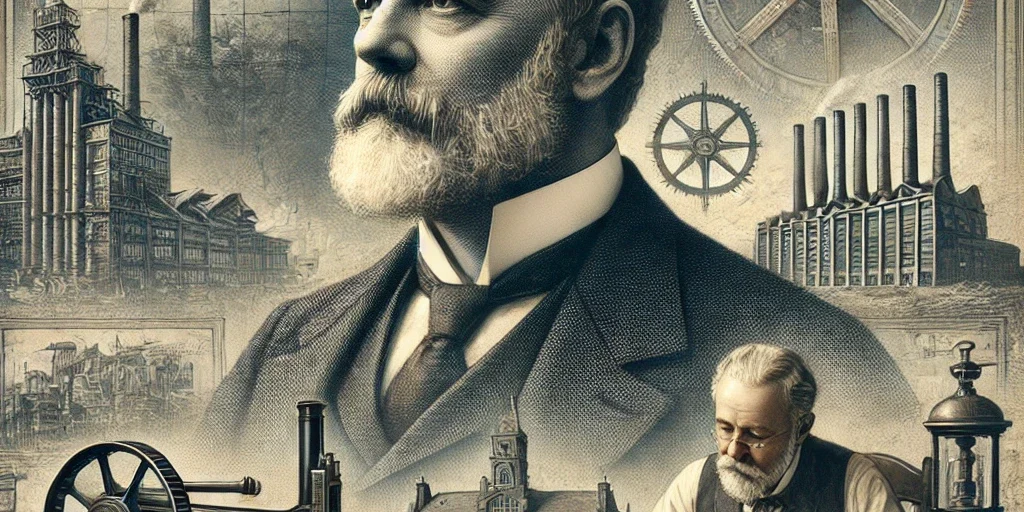The Life and Legacy of Andrew Carnegie
Few names are as synonymous with American industry and philanthropy as Andrew Carnegie. Born into poverty in Scotland, Carnegie’s rise to become one of the wealthiest men in history is a tale of ambition, innovation, and ruthless business tactics. Yet, his legacy extends far beyond steel—Carnegie dedicated the latter part of his life to giving away his immense fortune, shaping education, libraries, and institutions that continue to impact the world today. This is the story of Andrew Carnegie’s journey, from an impoverished immigrant to a titan of industry and, ultimately, a champion of philanthropy.
Humble Beginnings: From Scotland to Pittsburgh
Andrew Carnegie was born on November 25, 1835, in Dunfermline, Scotland. His father was a weaver, but as industrialization displaced traditional craftsmen, the family struggled. In 1848, seeking a better life, the Carnegies emigrated to the United States, settling in Allegheny City (now Pittsburgh’s North Side).
Young Andrew’s first job was as a bobbin boy in a textile mill, earning $1.20 per week. Ambitious and eager to learn, he later became a telegraph messenger and then a personal assistant to Thomas A. Scott, a high-ranking official at the Pennsylvania Railroad. Scott became Carnegie’s mentor, teaching him the importance of investing and expanding industries—a lesson Carnegie would take to heart.
Building a Steel Empire
Carnegie’s entry into the steel business began in the 1860s, as he recognized the potential of steel over iron in railroads and construction. By 1875, he opened the J. Edgar Thomson Steel Works, named after a Pennsylvania Railroad executive. His embrace of the Bessemer process, a revolutionary method for producing steel quickly and efficiently, allowed Carnegie’s mills to outproduce competitors.
Through aggressive cost-cutting, vertical integration, and ruthless labor policies, Carnegie Steel became the dominant force in American steel production. By the 1890s, Carnegie’s mills produced more steel than all of Great Britain. His company supplied steel for railroads, bridges, skyscrapers, and naval ships, fueling America’s industrial expansion.
However, Carnegie’s empire was built on the backs of laborers working in brutal conditions. His mills operated under grueling 12-hour shifts, six days a week, with little regard for worker safety. The most infamous episode came in 1892, during the Homestead Strike, when steelworkers at Carnegie’s Homestead Steel Works protested wage cuts. Carnegie’s partner, Henry Clay Frick, brought in Pinkerton agents to break the strike, leading to a violent battle that left several dead and many more wounded. Though Carnegie was in Scotland at the time, his reputation suffered from the brutal crackdown.
In 1901, Carnegie decided to sell his steel empire to J.P. Morgan for $480 million (roughly $15 billion in today’s dollars). Morgan merged Carnegie Steel into U.S. Steel, the first billion-dollar corporation in history. With that sale, Carnegie retired from business—but his most influential chapter was yet to come.
The Gospel of Wealth: Carnegie the Philanthropist
Carnegie firmly believed in the principle he called the “Gospel of Wealth”—the idea that the wealthy had a moral obligation to use their fortunes for the public good. Unlike other industrialists of his time who hoarded wealth for their families, Carnegie declared: “The man who dies rich dies disgraced.”
He set out to distribute nearly all of his fortune before his death. Among his most notable contributions:
- Public Libraries – Carnegie funded over 2,500 libraries worldwide, including more than 1,600 in the U.S., believing knowledge should be accessible to all.
- Carnegie Mellon University – Originally founded as Carnegie Technical Schools in 1900, it later became Carnegie Mellon University, a world-renowned institution for science and technology.
- Carnegie Hall – One of the most famous music venues in the world, established in New York City in 1891.
- The Carnegie Endowment for International Peace – A foundation dedicated to diplomacy and global cooperation.
- Scientific and Educational Institutions – He funded organizations like the Carnegie Institution for Scienceand the Carnegie Hero Fund, which still exists today.
By the time of his death in 1919, Carnegie had given away over $350 million—nearly 90% of his wealth—leaving a lasting legacy that continues to shape the world.
Carnegie’s Complex Legacy
Andrew Carnegie remains a deeply complex figure. He was both a visionary builder and a ruthless capitalist. He drove workers to exhaustion yet gave away his fortune to advance knowledge and culture. The man who oversaw the Homestead Strike also created thousands of libraries that uplifted generations.
His impact is undeniable. Pittsburgh, America, and the world continue to benefit from his philanthropy. Libraries, universities, and institutions bearing his name stand as monuments—not just to his wealth, but to his belief in education and opportunity for all.
Andrew Carnegie’s story is a reminder of both the power and the responsibility that come with great wealth. He built an empire of steel, but his greatest legacy is the one of learning, music, and progress that he left behind.
What do you think of Andrew Carnegie’s legacy? Was he a ruthless businessman, a generous philanthropist, or both? Share your thoughts in the comments!









